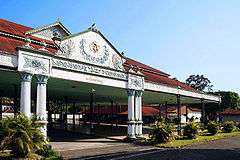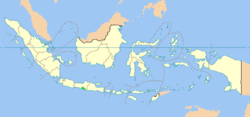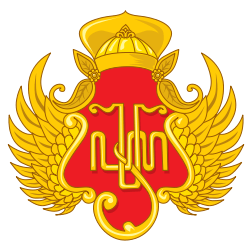Special Region of Yogyakarta
| Yogyakarta ꦔꦪꦺꦴꦒꦾꦏꦂꦠ | |||
|---|---|---|---|
| Special Region | |||
|
Special Administrative Region of Yogyakarta Daerah Istimewa Yogyakarta ꦣꦲꦺꦫꦃꦲꦶꦯ꧀ꦡꦶꦩꦺꦮꦔꦪꦺꦴꦒꦾꦏꦂꦠ | |||
  Clockwise, from top left : Fishermen line up at Baron Beach in the Gunung Kidul regency, Malioboro street, Parangtritis Beach, Kraton of Yogyakarta, Fort Vredeburg, Mount Merapi from Kaliurang, Prambanan Temple | |||
| |||
| Nickname(s): Jogja | |||
|
Motto(s): ꦲꦩꦼꦩꦪꦸꦲꦪꦸꦤꦶꦁꦧꦮꦤ (Javanese) (meaning: "The Vision to Perfect Society") | |||
 Location of the Special Region of Yogyakarta in Indonesia | |||
| Coordinates: 7°47′S 110°22′E / 7.783°S 110.367°ECoordinates: 7°47′S 110°22′E / 7.783°S 110.367°E | |||
| Country |
| ||
| Capital |
| ||
| Established | March 4, 1950 | ||
| Government | |||
| • Governor (Sultan) | Hamengkubuwana X | ||
| • Vice Governor (Paku Alam) | Paku Alam X | ||
| Area | |||
| • Total | 3,133.15 km2 (1,209.72 sq mi) | ||
| Area rank | 33rd | ||
| Highest elevation | 2,930 m (9,610 ft) | ||
| Population (2014)Provincial Estimate[1] | |||
| • Total | 3,594,290 | ||
| • Rank | 18th | ||
| • Density | 1,100/km2 (3,000/sq mi) | ||
| Demographics | |||
| • Ethnic groups |
Javanese (95.82%) Sundanese (0.56%) Others (4.45%)[2] | ||
| • Religion |
Islam (91.4%) Christianity (8.3%) Hinduism and Buddhism (0.3%)[3] | ||
| • Languages |
Javanese Indonesian (both official) | ||
| Time zone | UTC+7 (WIB) | ||
| Vehicle registration | AB, YB (for Rickshaws), YK (for Dokars) | ||
| HDI |
| ||
| HDI rank | 2nd (2014) | ||
| GDP PPP (2011) |
| ||
| Website | www.jogjaprov.go.id | ||
The Special Administrative Region of Yogyakarta (Javanese: ꦣꦲꦺꦫꦃꦲꦶꦯ꧀ꦡꦶꦩꦺꦮꦔꦪꦺꦴꦒꦾꦏꦂꦠ, occasionally pronounced /ˌjɒɡjəˈkɑːrtə/ or /ˌjoʊɡjəˈkɑːrtə/;[5] Indonesian: Daerah Istimewa Yogyakarta (DIY), or simply Yogyakarta) is a region of Republic of Indonesia in the middle of Java. Its administrative capital is city of Yogyakarta.
Although it is a separate administrative entity, Yogyakarta is historically and culturally part of Central Java. Yogyakarta's unwavering support for Indonesia and Sultan Hamengkubuwono IX's patriotism were essential in the Indonesian struggle for independence during the Indonesian National Revolution (1945-1949). It is now the only region in Indonesia that is still governed by a pre-colonial monarchy, the Sultan of Yogyakarta, who serves as the hereditary leader of the region. The current Sultan is Hamengkubuwono X.
In Javanese it is pronounced [joɡjaˈkartɔ], and named after the city of Ayodhya in Javanese-Hindu mythology.[6]
The Dutch name of the Special Region is Djokjakarta.
History

The Sultanate has existed in various forms through prehistory, and survived through the rule of the Dutch and the 1942 invasion of the Dutch East Indies by the Japanese Empire. In August 1945 Indonesia's first president, Sukarno proclaimed the independence of the Indonesian Republic, and by September of that year, Sultan Hamengkubuwono IX and duke Sri Paku Alam VIII had sent letters to Sukarno expressing their support for the newly-born nation of Indonesia, in which they acknowledged the Yogyakarta Sultanate as part of the Indonesian Republic. The Sunanate of Surakarta did the same, and both of the Javanese kingdoms were awarded special status as special regions within Indonesian Republic. However, due to a leftist anti-royalist uprising in Surakarta, the Sunanate of Surakarta lost its special administrative status in 1946 and was absorbed into the province of Central Java.
Yogyakarta's overwhelming support and the Sultan's patriotism were essential in the Indonesian struggle for independence during the Indonesian National Revolution (1945-1949). The city of Yogyakarta became the capital of the Indonesian Republic from January 1946 to December 1948 after the fall of Jakarta to the Dutch. Later, the Dutch also invaded Yogyakarta causing the Indonesian Republic's capital to be transferred again to Bukittinggi in West Sumatra on 19 December 1948. In return for Yogyakarta's support, the declaration of Special Authority over Yogyakarta was granted in full in 1950 and Yogyakarta was given the status as a Special Administrative Region, making Yogyakarta the only region headed by a monarchy in Indonesia.
The Special Region was struck by a 6.3-magnitude earthquake on 27 May 2006, killing 5,782 people, injuring approximately 36,000 and leaving 600,000 people homeless.[7] The region of Bantul suffered the most damage and deaths.
Geography
The Special Region is located near the southern coast of Java, surrounded on three sides by the province of Central Java, and with the Indian Ocean on the south side. The population at the 2010 Census was 3,452,390 people, but according to the latest official estimate (January 2014) has risen to 3,594,290. It has an area of 3,133.15 km2, making it the second-smallest area of the provinces in Indonesia, after the Jakarta Capital Region. Along with surrounding areas in Central Java, it has some of the highest population densities of Java.
Mount Merapi is located to the immediate north of the city of Yogyakarta and Sleman Regency. It is the most active volcano in Indonesia and has erupted regularly since 1548. It last erupted in October–November 2010, killing and injuring many people and temporarily displacing approximately 100,000 residents.[8][9]
Geo-heritage sites
Indonesia has numbers of geo-heritage sites in Yogyakarta Special Region. It has been declared by Geological Agency of the Energy and Natural Resources Ministry. The sites consists of 9 sites: Eosen limestone in Gamping (Sleman regency), pillow lava in Berbah (Sleman), pre-historic volcanic sediment in Candi Ijo, Prambanan (Sleman), sand dunes in Parangtritis Beach (Bantul regency), Kiskendo cave and former manganese mining site in Kleripan (Kulonprogo regency), the prehistoric volcano in Nglanggeran (Gunungkidul regency), Wediombo-Siung beaches (Gunungkidul) and Bioturbasi site in Kalingalang (Gunungkidul). The most unusual one is pillow lava in Berbah (Sleman) which is a big, rough black rock lays on the bank of narrow Dengkeng River. While the prehistoric volcano in Nglanggeran (Gunungkidul regency) has already been developed as a tourist destination with its beautiful scenery.
Administrative divisions
The Special Region of Yogyakarta (provincial level) is subdivided into four regencies (kabupaten) and one city (kota):
| Name | Capital | Area (km²) | Population 2000 Census | Population 2005 estimate | Population 2010 Census | Population 2014 estimate | HDI[10] 2014 Estimates |
|---|---|---|---|---|---|---|---|
| Yogyakarta City | Yogyakarta City | 32.50 | 396,700 | 433,539 | 388,627 | 404,003 | 0.837 (Very High) |
| Bantul Regency | Bantul | 508.13 | 781,000 | 859,968 | 911,503 | 947,568 | 0.771 (High) |
| Gunung Kidul Regency | Wonosari | 1,431.42 | 670,400 | 681,554 | 675,382 | 702,104 | 0.670 (Medium) |
| Kulon Progo Regency | Wates | 586.28 | 371,000 | 373,757 | 388,869 | 404,155 | 0.706 (High) |
| Sleman Regency | Sleman | 574.82 | 901,400 | 988,277 | 1,093,110 | 1,136,360 | 0.807 (High) |
| Totals | 3,133.15 | 3,121,045 | 3,337,095 | 3,457,491 | 3,594,290 | 0.768 (High) |
Located within the Special Region of Yogyakarta, the city of Yogyakarta is known as a center of classical Javanese fine art and culture such as batik, ballet, drama, music, poetry and puppet shows. It is also one of Indonesia's most renowned centers of higher education. At the city's center is the Sultan's palace called the kraton. While the city sprawls in all directions from the kraton, the core of the modern city is to the north.
Demographics
Religion
Transport
Yogyakarta is served by Adisucipto International Airport. There are two train stations: Lempuyangan and Yogyakarta (also
| Historical population | ||
|---|---|---|
| Year | Pop. | ±% |
| 1971 | 2,489,360 | — |
| 1980 | 2,750,813 | +10.5% |
| 1990 | 2,913,054 | +5.9% |
| 1995 | 2,916,779 | +0.1% |
| 2000 | 3,122,268 | +7.0% |
| 2010 | 3,452,390 | +10.6% |
| 2014 | 3,594,290 | +4.1% |
| Source: Badan Pusat Statistik 2010 | ||
called Tugu station). Yogyakarta is considered one of the major hubs that links the west-east main railway route in Java island. Tugu railway station is the main train station located in center, and Lempuyangan train station is the second train station in the city. The two stations have own schedule from and to other cities in Java island. To the south, in the Bantul region, is the Giwangan bus station, the largest bus station in Indonesia. The centre of metropolitan Yogyakarta is surrounded by a ring road.
Since 2008, the Special Region of Yogyakarta launched bus rapid transit system, the Trans Jogja, which connects many places in and around Yogyakarta city, including the airport and Prambanan temple. Today, Trans Jogja has reached other points in the south-side of the city[12]
Education
Yogyakarta is home to more than 100 institutions[13] of higher education in Indonesia, the highest number of higher education institutions of any province in Indonesia. Hence, Yogyakarta earned its nickname "Kota Pelajar" (The City of Students).
Yogyakarta is the home of the first established state university in Indonesia, the Gadjah Mada University.
The Special Region is also the home of the first-established private university in Indonesia, the Islamic University of Indonesia, which was founded in 1945. The Indonesia Institute of Arts, the first-established university in fine arts, is also in the region. Other large universities include State Islamic University of Yogyakarta, University of Sarjanawiyata Tamansiswa in Yogyakarta, Yogyakarta State University, Muhammadiyah University of Yogyakarta and University of Atma Jaya Yogyakarta. Yogyakarta also has the famous one of university in mining and energy sector in Indonesia there is University of Pembangunan Nasional "Veteran Yogyakarta.
Sister relationships
Yogyakarta Special Region have signed sister province relationship or friendly ties agreement with region/state:





See also
Notes
- ↑ http://yogyakarta.bps.go.id/index.php?r=site/page&view=sosduk.tabel.3-1-1
- ↑ Indonesia's Population: Ethnicity and Religion in a Changing Political Landscape. Institute of Southeast Asian Studies. 2003.
- ↑ Kementerian Agama Republik Indonesia Wilayah DIY (2010-03-15). "Kementerian Agama RI | Kantor Wilayah DI Yogyakarta". Yogyakarta.kemenag.go.id. Retrieved 2011-02-07.
- ↑ "Statistik Indonesia". Archived from the original on 2016-11-13.
- ↑ "Yogyakarta | Define Yogyakarta at Dictionary.com". Dictionary.reference.com. Retrieved 2011-06-05.
- ↑ "Raffles and the British Invasion of Java," Tim Hannigan, Monsoon Books, 2012, ISBN 9789814358866, .. Its full formal name was Ngayogyakarta Hadiningrat. Like the Thai town of Ayutthaya, Yogyakarta was named for Ayodhya, mythical birthplace of the Hindu god Rama ..
- ↑ "Indonesia lowers quake death toll". CNN. 2006-06-06. Archived from the original on 2006-06-15. Retrieved 2006-06-06.
- ↑ "Update: Indonesia Volcano Death Toll Soars Past 100; 'Many Children Dead, by Gandang Sajarw". Jakarta Globe. 2010-11-05. Archived from the original on 2012-07-22. Retrieved 2010-11-05.
- ↑ "Pictures: Indonesia's Mount Merapi Volcano Erupts". News.nationalgeographic.com. 2010-10-26. Retrieved 2011-02-07.
- ↑ Indeks-Pembangunan-Manusia-2014
- ↑ "Population by Region and Religion in Indonesia". BPS. 2010.
- ↑ "Trans Jogja Busway: Yogyakarta, Central Java". Indonesialogue.com. 2008-02-26. Archived from the original on 2012-07-22. Retrieved 2011-02-07.
- ↑ "List of private higher education institutions in the Province of Yogyakarta". Kopertis4.or.id. Archived from the original on 2004-08-26. Retrieved 2011-02-07.
- ↑ "Kyoto prefecture List of Friendly and Sister City". Pref.kyoto.jp. Retrieved 2011-02-07.
- ↑ "Gyeongsangbuk-do Province Website".
- ↑ Biro Kerjasama (2006). Bunga Rampai Kerjasama Luar Negeri Propinsi DIY. Yogyakarta: Pemerintah Propinsi DIY.
- ↑ "Archived copy" (PDF). Archived from the original (PDF) on 2016-08-16. Retrieved 2016-06-23.
Primera Transport tour and travel agencies
References
- Regional Office of the Department of Tourism, Post and Telecommunication for the Special Region of Yogyakarta. (1997) Guide To Yogyakarta. Yogyakarta: Department of Tourism, Post and Telecommunication.
- Ricklefs, M.C. (2001) A history of modern Indonesia since c.1200 (3rd ed.). Stanford: Stanford University Press. pp. 126–139, 269-271. ISBN 0-8047-4480-7
- Ricklefs, M.C. (1974) Jogjakarta under Sultan Mangkubumi, 1749–1792: A history of the division of Java. London Oriental Series, vol. 30. London : Oxford University Press, (Revised Indonesian edition 2002)
- Soemanto, Bakdi (1992) Cerita Rakyat dari Yogyakarta Jakarta: Grasindo (In Indonesian)
- Soemardjan, S. (1962) Social Changes in Yogyakarta, Ithaca, N.Y. Cornell University Press.
External links

- Yogyakarta Updates
- Yogyakarta Holidays Portal
- Yogyakarta tour & transport Advisor
- Sochaczewski, Paul Spencer (1994-06-14). "A True Javanese Fairy Tale: The Sultan and the Mermaid". The New York Times. Retrieved 2011-02-07.
| Wikimedia Commons has media related to Yogyakarta (Special Region). |


